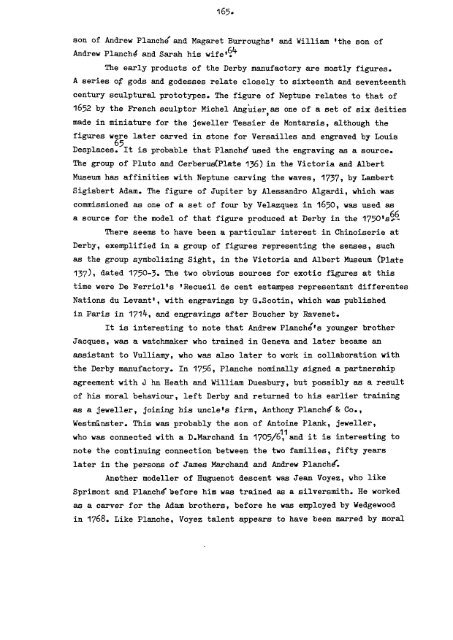HUGIJENOT ARTISTS DESIGNERS AND CRAYPSNEN IN GREAT ...
HUGIJENOT ARTISTS DESIGNERS AND CRAYPSNEN IN GREAT ...
HUGIJENOT ARTISTS DESIGNERS AND CRAYPSNEN IN GREAT ...
You also want an ePaper? Increase the reach of your titles
YUMPU automatically turns print PDFs into web optimized ePapers that Google loves.
165.<br />
son of Andrew Planch and Magaret Burroughs' and William 'the son of<br />
Andrew Planch4 and Sarah his wife'<br />
The early products of the Derby inanufactory are mostly figures.<br />
A series of gods and godesses relate closely to sixteenth and seventeenth<br />
century sculptural prototypes. The figure of Neptune relates to that of<br />
1652 by the French sculptor Michel Anguieras one of a set of six deities<br />
made in miniature for the jeweller Tessier de Montarsis, although the<br />
figures were later carved in stone for Versailles and engraved by Louis<br />
Desplaces. It is probable that Planch used the engraving as a source.<br />
The group of Pluto and Cerberus(Plate 136) in the Victoria and Albert<br />
Museum has affinities with Neptune carving the waves, 1737, by Lambert<br />
Sigisbert Adam. The figure of Jupiter by Alessandro Algardi, which was<br />
commissioned as one of a set of four by Velazquez in 1650, was used as<br />
a source for the model of that figure produced at Derby in the 1750's<br />
There seems to have been a particular interest in Chinoiserie at<br />
Derby, exemplified in a group of figures representing the senses, such<br />
as the group symbolizing Sight, in the Victoria and Albert Museum (Plate<br />
137), dated 1 750-3. The two obvious sources for exotic figures at this<br />
time were De 'Pecueil de cent estampes representant differentes<br />
Nations du Levant', with engravings by G.Scotin, which was published<br />
in Paris in 171'+, and engravings after Boucher by Ravenet.<br />
It is interesting to note that Andrew Planche"s younger brother<br />
Jacques, was a watchmaker who trained in Geneva and later became an<br />
assistant to Vullianiy, who was also later to work in collaboration with<br />
the Derby manufactory. In 1756, Planche nominally signed a partnership<br />
agreement with J hn Heath and William Duesbury, but possibly as a result<br />
of his moral behaviour, left Derby and returned to his earlier training<br />
as a jeweller, joining his uncle's firm, Anthony Planch& Co.,<br />
Westminster. This was probably the son of Antoine Plank, jeweller,<br />
who was connected with a D.Marchand in 1705/6V and it is interesting to<br />
note the continuing connection between the two families, fifty years<br />
later in the persons of James Marcha.nd and Andrew Planch(.<br />
Another modeller of Huguenot descent was Jean Voyez, iho like<br />
Sprimont and Planch( before him was trained as a silversmith. He worked<br />
as a carver for the Adam brothers, before he was employed by Wedgewood<br />
in 1768. Like Planche, Voyez talent appears to have been marred by moral
















